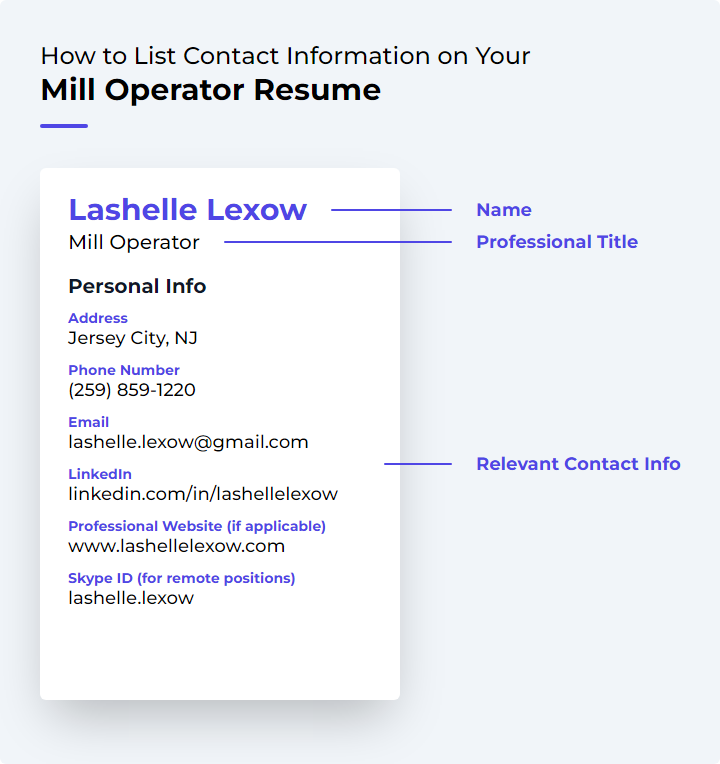Mill Operator Resume Examples
Writing a great mill operator resume is important because it is one of the first things a potential employer will see when they are considering you for a position. It is your opportunity to make a good first impression and sell yourself as the best candidate for the job.
Create your resume
Select from 7 professional resume templates
If you're looking for inspiration when it comes to drafting your own mill operator resume, look no further than the samples below. These resumes will help you highlight your experience and qualifications in the most effective way possible, giving you the best chance of landing the mill operator job you're after.
Essential Components of a Mill Operator Resume
A Mill Operator Resume is a critical tool that showcases an individual's qualifications, experience, and expertise for a position in mill operations. This role requires a solid grasp of technical skills and hands-on experience with various machinery, tools, and processes within a milling environment. A well-structured resume should be organized into key sections, including personal information, career objectives, employment history, skills, and educational background. Each section plays a crucial role in demonstrating the candidate's suitability for the mill operator position. In the following sections, we will delve into the specifics of a Mill Operator Resume, highlighting the importance of each part and providing tips to make your resume stand out.
1. Contact Information
The Contact Information section is the gateway to your resume, providing hiring managers with the means to contact you. It should be prominently placed, clear, and concise, typically including your full name, address, phone number, and a professional email address. Ensure these details are up-to-date and accurate.

- Ensure your full name aligns with your legal documents.
- Include your city and state in your address; omit or use a local address if job-seeking in other regions.
- Provide a reliable contact number.
- Use a professional email address to convey a serious image to potential employers.
Consider adding a LinkedIn profile or personal website if they contribute positively to your professional portrayal. This section sets the tone for your professional image, so it must be error-free and professional.
2. Objective Statement
The Objective Statement is a brief but impactful introduction to your resume. In one or two sentences, it should encapsulate your career aspirations and highlight the skills and experiences that qualify you for a mill operator role. Tailor this statement to align with the employer's mission and values.
An effective objective statement can immediately capture the attention of hiring managers, encouraging them to read further. It's an opportunity to differentiate yourself from other candidates by expressing your passion for the mill operator profession.
- Clarity: Your objective should be straightforward and easily understood.
- Conciseness: A succinct statement is often more impactful.
- Relevance: Focus on the mill operator role and your pertinent skills and experiences.
Related: Top Mill Operator Resume Objective Examples
3. Skills and Competencies
Highlighting specific skills and competencies is essential for a Mill Operator's resume. These skills help employers evaluate your ability to perform effectively in the role. Include:
- Technical Skills: Proficiency with machinery and tools, understanding of production processes, and knowledge of quality control are crucial.
- Problem-Solving Skills: Ability to identify and solve complex problems is key.
- Attention to Detail: Detecting minor issues in the milling process is important.
- Physical Stamina: The job often requires prolonged periods of standing or moving.
- Mathematical Skills: Basic math is necessary for measurements and monitoring production.
- Communication Skills: Effective verbal communication is essential for teamwork.
- Mechanical Knowledge: Understanding of machine maintenance and repair is important.
- Safety Consciousness: Knowledge of safety regulations is vital.
- Time Management Skills: The ability to manage multiple tasks efficiently is beneficial.
- Computer Literacy: Basic computer skills may be required for operating machinery or data entry.
These skills demonstrate your capability and commitment to quality and safety in the workplace.
Related: Mill Operator Skills: Definition and Examples
4. Work Experience
Your work experience is a testament to your practical knowledge and skills as a mill operator. It provides insight into your past responsibilities and proficiency with different milling equipment.
List your work history starting with the most recent position, including the employer's name, location, duration of employment, and your job title. Detail your responsibilities and achievements, using quantifiable data to illustrate your successes.
Highlight experience with various types of mills and industries, as well as any leadership roles you've held. This section should emphasize your technical expertise and soft skills such as problem-solving and teamwork.
5. Education and Certifications
Education and certifications can enhance your appeal to employers. Include your high school diploma or equivalent, any higher education, specialized trade training, and relevant certifications such as those from NIMS. Mention apprenticeships, internships, ongoing learning, and safety courses, listing them in reverse chronological order.
Related: Mill Operator Certifications
6. Machinery and Equipment Proficiency
Detail your expertise with machinery and tools commonly used in milling operations. Specify your proficiency level and any maintenance or troubleshooting experience. Include relevant certifications and emphasize your commitment to safety.
- Use this section to distinguish yourself by showcasing your unique machine operation skills.
7. References
References can influence the hiring decision by providing insights into your work ethic and professional abilities. Choose individuals who can vouch for your mill operator skills, such as former supervisors or colleagues. Provide their contact details and a brief description of your professional relationship.
- Avoid using personal acquaintances unless they were your supervisor in a professional context.
- Select references who can provide detailed insights into your professional competencies.
If space is limited or you prefer to keep references private, simply state "References available upon request."
